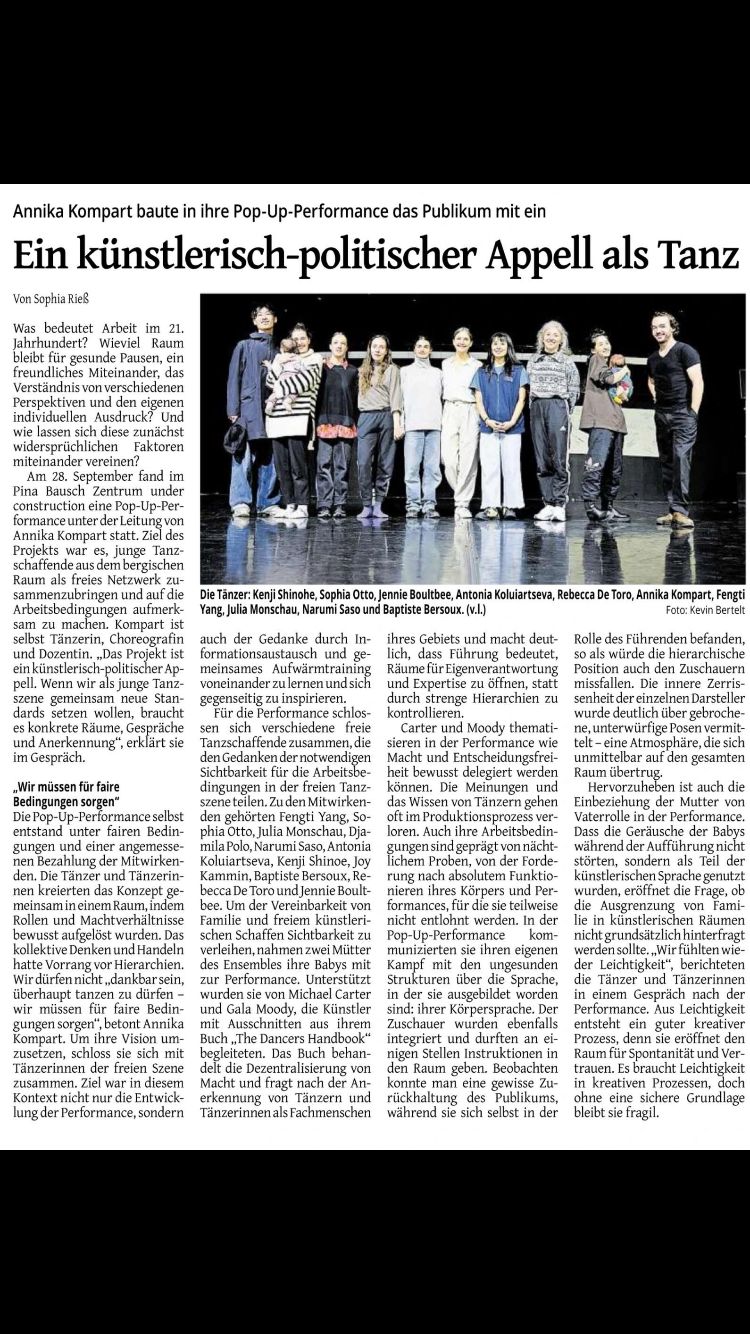WORKSHOP REVIEW
An Artistic-Political Appeal in the Form of Dance
By Sophia Rieß

(translated from german)
What does work mean in the 21st century? How much space is left for healthy breaks, friendly coexistence, an understanding of different perspectives, and one’s own individual expression? And how can these seemingly contradictory factors be brought together?
On September 28, a pop-up performance took place at the Pina Bausch Zentrum under construction, directed by Annika Kompart. The goal of the project was to bring together young dance artists from the Bergisch region as a free network and to draw attention to working conditions. Kompart herself is a dancer, choreographer, and lecturer. “The project is an artistic-political appeal. If we want to set new standards together in the young dance scene, we need concrete spaces, conversations, and connections,” she explained in an interview.
“We have to fight for fair working conditions”
The pop-up performance was created under fair conditions and with appropriate payment for the participants. The dancers developed the concept together in a space where roles and power relations were deliberately dissolved. Collective thinking and action were valued more highly than hierarchies. “We must not be grateful just for being allowed to dance at all – we have to fight for fair conditions,” emphasized Annika Kompart.
To realize her vision, she worked with dancers from the independent scene. The aim in this context was not only to develop the performance but also to inspire through the exchange of ideas and communal warm-ups, and to learn from one another.
For visibility, various freelance artists came together to share their ideas about the necessary transparency regarding working conditions in the independent dance scene. Among the participants were Fengti Yang, Sophia Otto, Julia Monschau, Djamila Polo, Narumi Saso, Antonia Koliuartseva, Kenji Shinohe, Joy Kammin, Baptiste Bersoux, Rebecca De Toro, and Jennie Boultbee.
To strengthen the association of family and free artistic work, two mothers in the ensemble brought their babies into the performance. Support came from Michael Carter and Gala Moody, who accompanied the artists with excerpts from their book “The Dancers Handbook.” The book addresses the decentralization of power and asks about the role of dancers as experts in their field, making it clear that leadership means opening up one’s own responsibility and expertise instead of controlling hierarchical structures.
Carter and Moody thematized in the performance how professional requirements often stand in conflict with one’s own wellbeing. These tensions were made visible in sequences of collective improvisations.
Babies as a conscious part of the performance
The pop-up performance communicated its ongoing struggle with the constraints of structures, such as language, in which one is trained or expected to function with the body and performance – even though part of oneself is not represented at all. The dancers shared instructions with the audience, which created a new sense of community and also demanded responsiveness from the audience itself.
Even the working conditions of the artists, shaped by night rehearsals, demands of absolute functionality of the body, and performances that are often unpaid, were addressed.
The sounds of the babies during the performance were deliberately not excluded but became part of the artistic process, raising the question of whether dance and family life can be reconciled at all. “In artistic work, lightness is often considered a basic requirement – as if lightness and family are incompatible,” said Annika Kompart in a discussion after the performance.
That lightness can also emerge through trust and freedom was demonstrated in the performance. Yet, as the group emphasized, this foundation remains fragile.

Leave a Reply
You must be logged in to post a comment.